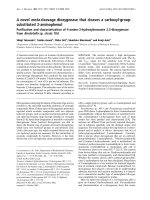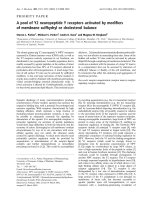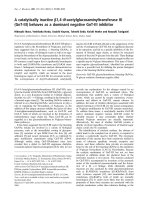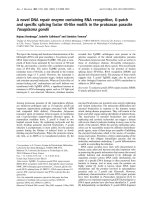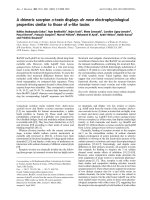Báo cáo y học: "A small solitary non-parasitic hepatic cyst causing an intra-hepatic bile duct stricture: a case report" pps
Bạn đang xem bản rút gọn của tài liệu. Xem và tải ngay bản đầy đủ của tài liệu tại đây (480.17 KB, 3 trang )
CAS E REP O R T Open Access
A small solitary non-parasitic hepatic cyst causing
an intra-hepatic bile duct stricture: a case report
Keunho Lee
1
, Taeho Hong
2*
Abstract
Introduction: We report an unusual presentation of a small hepatic cyst causing cholangitis.
Case presentation: A 70-year-old Asian man was hospitalized for aggravated chronic pain in the right upper
portion of his abdomen. Fever developed after admission. Laboratory tests revealed elevated hepatobiliary
enzymes, inflammatory markers and carbohydrate antigen 19-9 without hyperbilirubinemia. Ultrasound and
computed tomography demonstrated dilatation of the left intra-hepatic bile ducts. Endoscopic retrograde
cholangiopancreatography showed that the right intra-hepatic bile ducts were normally filled with contrast
medium, but the left intra-hepatic bile ducts were not seen in the confluence. A left hepatectomy was performed
because a hidden malignancy could not be excluded. The surgical findings showed no tumor around the bile duct
but rather a 2 cm cyst in segment four of Couinaud’s category of the liver around the hilum. The pathology report
was a solitary non-parasitic hepatic cyst compressing the bile duct.
Conclusion: A very small solitary hepatic cyst might cause hepatic duct stricture if it is located near the hepatic
hilum, and should be considered in the differential diagnosis of a hepatic duct stricture.
Introduction
Solitary non-parasitic hepatic cysts (SNHC) are usually
asymptomatic. Only a small fraction of them are asso-
ciated with symptoms such as abdominal pain, an
abdominal mass, early satiety, nausea, and vomiting.
These symptomatic SNHCs are usually larger than
10 cm and can cau se obstructive jaundice and cholangi-
tis because of their mass effect on the bile ducts. In this
case, we present a 70-y ear-old man with a very small
(2 cm) cyst in the hepatic hilum compressing the left
hepatic duct.
Case presentation
A 70-year-old Asian man presented to the out-patient
depar tment complaining of pain in the upper portion of
his abdomen. The pain, which started seven months
previously, had worsened, and our patient complained
of fever and chills with the pain. However, he was never
hospitalized and did not recall any prior medical evalua-
tion for this problem. The patient denied any other
systemic symptoms such as nausea, vomiting, jaundice,
and weight loss. He had no significant medical history
and was not taking any medication.
On physical examination, our patient’ s temperature
was 38.3°C with a blood pressure o f 129/67 mmHg, a
heart rate of 89 beats per minute and a respiratory rate
of 18 breaths per minute. The abdominal examination
revealed localized tenderness to palpation in the right
upper quadrant but no guarding, rebound, or percussion
tenderness. The rest of the physical findings were
unremarkable.
Laboratory investigation showed the following results:
white blood cell count 16.4 × 10
9
/L with a predomi-
nance of neutrophils, aspartate aminotransfera se 72 I U/
L, alanine aminotra nsferase 137 IU/L, total bilirubin 0.7
mg/dL, direct bilirubin 0.5 mg/dL, alkaline phosphatase
405 IU/L, and gamma glutamyl transpeptidase 155 IU/L.
The carbohydrate antigen 19-9 level was slightly ele-
vated (49.1 U/mL) and the carcinoembryonic antigen
level was within the normal range.
Ultrasound (US) was performed first. This showed a
distend ed gallbladder with sludge in it and dilated intra-
hepatic bile ducts (IHBD). Endoscopic retrograde cho-
langiopancreatography (ERCP) showed that the right
* Correspondence:
2
Department of Surgery, Seoul ST. Mary’s Hospital, College of Medicine, The
Catholic University of Korea, Seoul, Korea
Full list of author information is available at the end of the article
Lee and Hong Journal of Medical Case Reports 2010, 4:254
/>JOURNAL OF MEDICAL
CASE REPORTS
© 2010 Lee and Hong; licensee BioMed Central Ltd. This is an Open Access article dist ributed under the terms of the Creativ e
Commons Attribution License (http://creativecom mons.org/licenses/by/2.0), which permits unr estricted use, distribution, and
reproduction in any medium, provided the original work is properly cited.
IHBD normally filled with the contrast medium, but the
left IHBD could not be differentiated from the conflu-
ence. We assumed that the left hepatic duct was com-
pressed by something or that there was a stricture at
this site; perhaps caused by a tumor near the hepatic
hilum. An abdominal contrast-enhanced computed
tomography (CT) was performed to confirm the find-
ings. However, no abnormality was detected except for
the dilated left hepatic bile ducts on the CT scans (Fig-
ure 1). An intra-operative US failed to gain any further
informationbeyondthatobtainedthroughthepre-
operative US.
We performed a left hepatectomy on July 11, 2007
because we could not exclude a malignancy of the left
hepatic duct. There were mild adhesive changes around
the liver that might have been caused by cholangitis. No
tumor lesions were found around the bile duct. Only a
small hepatic cyst (1.5 × 2.0 cm size) was present, in
segment four accor ding to Couinaud’ s classification at
thelevelofthetransversefissure,compressingtheleft
hepatic duct (Figure 2). It was confirmed as a solitary
benign non-parasitic cyst lined by a single layer of
cuboidal epithelium on histological examination (Figure
3). Our patient made an uneventful recovery and at the
five-month follow-up, he was asymptomatic and a ll
laboratory findings had normalized.
Discussion
SNHCs are usually asymptomatic but may occasionally
present with abdominal pain, an abdominal mass, early
satiety, nausea, and vomiting. However, even with symp-
tomatic hepatic cysts, obs tructive jaundice or cholangitis
is rarely seen. Several reports on SNHC causing
obstruct ive jaundice are presented in the medical litera-
ture since first described by Caravati et al. in 1950 [1].
Most prior cases were over 10 cm and the symptoms
usually resulted from a mass effect of the enlarging cyst
on the neighboring bile ducts [2,3]. However, Tsuyoshi
et al. and Matthieu et al. each reported very exceptional
cases of 3 cm and 4 cm sized SNHCs causing dilatation
of the IHBD [4,5]. Both of these small cysts were located
in segment four according to Couinaud’s classification,
near the hepatic hilum. Our patient had a 2 cm cyst in
segment four at the level of the transverse fissure and
compressing the left hepatic duct. These cases demon-
strate that the position, as well as the size, of the cyst is
important for compression or stricture of the bile ducts.
Figure 1 CT. The dilated left IHBDs are seen but otherwise it is
normal. The arrow indicates a suspicious cyst on the review.
Figure 2 Intra-operative photograph. The small hepatic cyst
(arrow; 1.5 × 2.0 cm in size) was near the confluence of the right
and left hepatic ducts compressing the left hepatic duct (arrow
head).
Figure 3 Microscopic finding (×40). The hepatic cyst (arrow)
compresses the hepatic duct (arrowhead) and there is no
communication between the two structures.
Lee and Hong Journal of Medical Case Reports 2010, 4:254
/>Page 2 of 3
IHBD strictures can be malignant or benign. Malig-
nant causes are mostly cholangiocarcinoma, hepatocellu-
lar cancer and metastatic cancers to the liver. While
benign causes are numerous and include recurrent pyo-
genic cholangitis related to hepatolithiasis (previously
known as Oriental cholangiohepatitis), primary sc lero s-
ing cholangitis, radiation, blunt abdominal trauma, poly-
arteritis nodosa and systemic lupus erythematosus,
tuberculosis and histoplasmosis, chemotherapeutic drugs
infused into the hepatic artery, a choledochal cyst, cystic
fibrosis with liver involvement, space occupying lesions
in the liver such as SNHC, focal nodular hyperplasia
and hemangioma, eosinophilic cholangitis, idiopathic
and others [6].
The standard treatment is surgical resection for malig-
nant biliary stricture. However, balloon dilation or stent
insertion has been at tempted for benign strictures with-
out the require ment for extensive surgical resection. In
addition, deroofing of the cyst, partial hepatectomy
including the cyst, percutaneous drainage of the cyst,
and the administration of a sclerosing agent can be used
as less invasive methods for the treatment of a sympt o-
matic hepatic cyst. However, the differentiation of
benign and malignant bile duct strictures is not easy
pre-operatively; in cases with a bile duct stricture with-
out a demonstrable mass on CT or US, the distinction
cannot be made.
This case represents the smallest SNHC reported to
date with symptoms. We could not identify the cyst
prior to surgery and had no information on the cause of
the left hepatic duct stricture from the imaging studies
used in the evaluation, US, ERCP and CT. We per-
formed a left hepatectomy because we could not exclude
a malignancy. Because a 2 cm cyst could theoretically be
seen on an US or CT, we reviewed the imaging studies
retrospectively and found that there was a lesion that
could be regarded as cyst on the CT (Figure 1). How-
ever, the echogenicity and density of the cyst were so
similar to the neighboring ducts, we missed it. In addi-
tion, it might have been difficult to accept that such a
small cyst could cause a biliary stricture even i f it was
detected on the pre-operative imaging studies.
If the differential diagnostic markers such as tumor
markers, radiological evaluations, cytology by endoscopic
approaches, and tissue diagnosis were reliable for the
differentiation of benign from malignant bile duct stric-
tures, a less invasive treatment modality might have
been appropriate. There have been several reports on
the accuracy of the diagnostic markers for the differen-
tiation of benign from malignant bile duct strictures.
However, none of these markers are universally accepted
for a definitive diagnosis to date [7,8]. This case illu-
strated that a small SNHC could cause a biliary stricture
if in the r ight location. However, differentiation of
benign from malignant disease can be difficult, especially
when the imaging studies show no demonstrable mass
lesion.
Conclusions
A very s mall solitary hepatic cyst might cause hepatic
duct stricture if it i s located near the hepatic hilum, and
should be considered in the differential diagnosis of a
hepatic duct stricture.
Consent
Written informed consent was obtained from the patient
for publication of this case report and any accompany-
ing images. A copy of the writ ten consent is available
for review by the Editor-in-Chief of this journal.
Abbreviations
CT: computed tomography; ERCP: endoscopic retrograde
cholangiopancreatography; IHBD: intra-hepatic bile ducts; SNHC: solitary non-
parasitic hepatic cysts; US: ultrasound.
Author details
1
Department of Surgery, Incheon ST. Mary’s Hospital, College of Medicine,
The Catholic University of Korea, Incheon, Korea.
2
Department of Surgery,
Seoul ST. Mary’s Hospital, College of Medicine, The Catholic University of
Korea, Seoul, Korea.
Authors’ contributions
TH collected the information and carried out the research. He was the main
writer of the manuscript. KL advised, read and approved the final version.
Competing interests
The authors declare that they have no competing interests.
Received: 23 October 2009 Accepted: 7 August 2010
Published: 7 August 2010
References
1. Caravati CM, Watts TD: Benign solitary non-parasitic cyst of the liver.
Gastroenterology 1950, 14:317-320.
2. Miyamoto M, Oka M, Izumiya T: Nonparasitic solitary giant hepatic cyst
causing obstructive jaundice was successfully treated with
monoethanolamine oleate. Intern Med 2006, 45:621-625.
3. Ishikawa H, Uchida S, Yokokura Y: Nonparasitic solitary huge liver cysts
causing intracystic hemorrhage or obstructive jaundice. J Hepatobiliary
Pancreat Surg 2002, 9:764-768.
4. Inaba T, Nagashima I, Ogawa F, Tomioka M, Okinaga K: Diffuse intrahepatic
bile duct dilation caused by a very small hepatic cyst. J Hepatobiliary
Pancreat Surg 2003, 10:106-108.
5. Lapeyre M, Mathieu D, Tailboux L, Rahmouni A, Kobeiter H: Dilatation of
the intrahepatic bile ducts associated with benign liver lesions: an
unusual finding. Eur Radiol 2002, 12:71-73.
6. Frattaroli FM, Reggio D, Guadalaxara A, Illomei G, Pappalardo G: Benign
biliary strictures: a review of 21 years of experience. J Am Coll Surg 1996,
183:506-513.
7. Kim HJ, Lee KT, Kim SH: Differential diagnosis of intrahepatic bile duct
dilatation without demonstrable mass on ultrasonography or CT: benign
versus malignancy. J Gastroenterol Hepatol 2003, 18:1287-1292.
8. Babu S, Smithson J: Bile duct stricture: benign or malignant? J R Soc Med
2002, 95:302-304.
doi:10.1186/1752-1947-4-254
Cite this article as: Lee and Hong: A small solitary non-parasitic hepatic
cyst causing an intra-hepatic bile duct stricture: a case report. Journal of
Medical Case Reports 2010 4:254.
Lee and Hong Journal of Medical Case Reports 2010, 4:254
/>Page 3 of 3
